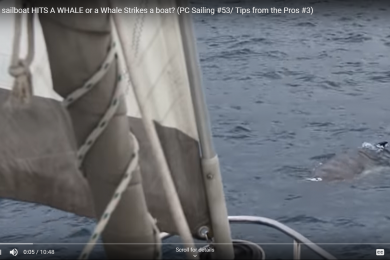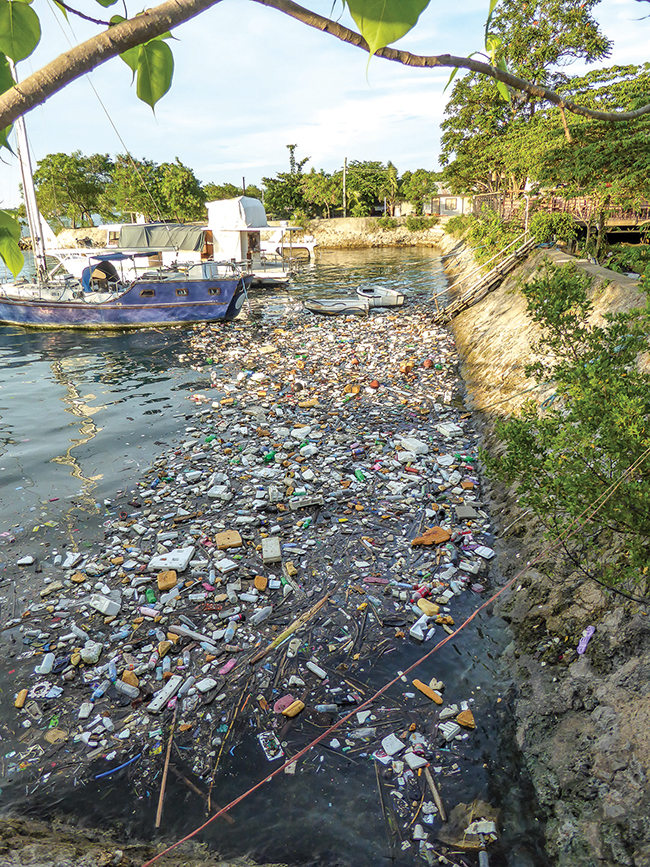Provisioning, food storage and meal prep require a lot of time and effort when you must organize and cook almost every meal you eat. Making small, conscious changes in your routine doesn’t take much effort, but it will make a difference both in your galley and on the planet. (published June 2018)
I’ve been interested in making our lives more sustainable since we moved onboard Kate in 2008. I actively make decisions to lower our impact on the environment, especially when it comes to a place where I love to spend my time; the galley.
REDUCE, REUSE, RECYCLE
For decades it seems like this slogan was practiced backwards; the emphasis always put on the end action, recycling packaging. In recent years, with the startling realization of what plastics, their use and manufacture, are doing to our environment the focus has finally shifted to reducing waste.
In fact, people are even trying to live “zero waste.” By rejecting single-use plastics such as straws and plastic bags, choosing package-free products and mindfully reducing the amount of unnecessary “stuff” they bring into their daily lives, they strive to create little or no waste. The old slogan has been updated: Refuse, Reduce, Reuse and Recycle.
“Refuse” and “Reduce” are a great way to start greening up your galley, especially since many of the places we visit don’t have the infrastructure to support recycling programs. Local markets are the place to find fresh produce, almost always without packaging, but transporting the fruit and veg back to the boat requires a bit of planning.
A smart way to avoid single-use plastics is to pack reusable produce bags and larger carry bags when you go provisioning. My produce bags are not cotton and many would point out that polyester is still a plastic. However, they are made of 66 percent post-consumer recycled materials, so at least they are working toward being better plastic. Light and small but durable and strong they carry everything from the most delicate lettuce to a dozen potatoes. I regularly take them to the market and, when we occasionally shop at a grocery store. The staff at the weigh station are happy to slap the price sticker on my reusable bag rather than a plastic one. They wash easily and have been in regular use for the past five years, saving me from bringing countless, flimsy plastic bags into the galley. My everyday carry bags have evolved over the past decade. In need of something strong I started with a bulky canvas tote. It did the job, but due to its considerable size I only used it when I specifically went on a provisioning run. I was still bringing home the daily incidentals in plastic bags. Then for years I had a selection of lightweight, foldable shopping bags that we used until there were holes in bottom and the seams were coming apart. I had trouble finding a suitable replacement, ones that were both durable and affordable, not just inexpensive and cheaply made.
 Bagpodz, a system of reusable, sustainable shopping bags, checked all the boxes. Available in a five or 10 bag pack, each set comes in a compact tube designed to be easy to use, and hard to forget at home. The bags are dispensed through a large zipper one at a time, making it quick and easy to pack away a large load.
Bagpodz, a system of reusable, sustainable shopping bags, checked all the boxes. Available in a five or 10 bag pack, each set comes in a compact tube designed to be easy to use, and hard to forget at home. The bags are dispensed through a large zipper one at a time, making it quick and easy to pack away a large load.
The colorful ripstop nylon bags are about the size of standard plastic grocery bags but are rated to carry 50 pounds each and are water repellant, perfect for those heavy loads and not so dry dinghy trips home. With a clip large enough to fit over the handle of a grocery cart handle the Bagpodz five pack is small enough to fit in my purse, which means that I can refuse plastic bags everyday, not just on planned outings.
What I like most about Bagpodz is that the company uses bluesign® certified materials. Bluesign® is an international system that works to ensure that “the textile industry manages the natural resources soundly and responsibly, reduces water and air emissions, improves its waste water treatment and generally reduces its ecological footprint.” By choosing Bagpodz I can refuse plastic bags, as well as support a global organization that works to reduce the impact that manufacturing the product has on the environment. That’s smart shopping.
WASTE NOT, WANT NOT
Over the years I have gotten pretty good at shrinking recipes to feed just the two of us and upcycling leftovers into creative next-day meals. Even so, I still find myself tossing out food that was forgotten in the fridge or neglected on the counter. This year my top galley goal is to reduce food waste.
I started by being more conscience of what food stuffs I have on board, trying to use up all the fresh goods before they spoil, and sorting through cans and dry goods before buying more. I regularly ferment and make preserves on board, both as means of conservation and to avoid the waste of prepackage items, but I am always on the lookout for other methods of food preservation.
 I have long been interested in dehydrating fruit, but I haven’t had much success making my own drying racks or keeping the critters at bay. Although electric dehydrators are inexpensive we neither have the space or the power to keep one on board, so I had long given up on the idea. A few months ago, I discovered the Food PANtrie, a hanging, non-electric food dehydrator and I have been madly dehydrating ever since.
I have long been interested in dehydrating fruit, but I haven’t had much success making my own drying racks or keeping the critters at bay. Although electric dehydrators are inexpensive we neither have the space or the power to keep one on board, so I had long given up on the idea. A few months ago, I discovered the Food PANtrie, a hanging, non-electric food dehydrator and I have been madly dehydrating ever since.
Measuring 14.5 inches square and 36 inches tall when hanging, the Food PANtrie folds down to a modest three inches thick. It has five drying trays that are enclosed in a mesh net, which is fine enough to keep even the smallest ants and fruit flies out, but easily unzips and tucks away when you are loading and unloading the trays. A hard top and bottom create a shell that protects the delicate mesh when collapsed, so nothing gets damaged while fitting it into a storage compartment. The best part is that the Food PANtrie uses only passive solar heat, so there is no leaving an appliance plugged in unattended, and there is no drain on the batteries.
I have been taking advantage of tropical fruits in the Philippines, filling my dehydrator with mangoes, pineapples, papaya and bananas. The process of dehydrating is simple: cut up the fruit, arrange on trays and hang in the sun. In three-to-four days, depending on the weather, you have delicious dried fruit, without any added sugar or preservatives. The Food PANtrie can also be used for making jerky, drying herbs and sprouting, especially if you like wheatgrass. When tomato season comes around I am really looking forward to making my own sundried tomatoes.
Dehydrating is a terrific way to make healthy on-the-go snacks for kids and a wonderful opportunity to teach the next generation of sailors about food waste and sustainability.
Another way I have been trying to reduce food waste is by exploring new ways to store food on board. Like most voyaging sailors I have a collection of heavy duty containers for storing leftovers, and my selection of glass canning jars also get used for keeping the unused portions of canned goods and small snacks. But produce, so irregularly shaped, usually ends up in a ziplock bag before it goes in our small fridge. Although I wash and reuse my ziplock bags for months I knew there had to be a better solution.
 I was a bit sceptical when I discovered Abeego, a washable, reusable, sustainable food wrap. Besides wondering the obvious – will it really keep foods fresher, longer like it claims – Abeego is, as the name implies, coated with beeswax. I was very concerned that it would turn into a sticky, unusable ball in the heat of the tropics.
I was a bit sceptical when I discovered Abeego, a washable, reusable, sustainable food wrap. Besides wondering the obvious – will it really keep foods fresher, longer like it claims – Abeego is, as the name implies, coated with beeswax. I was very concerned that it would turn into a sticky, unusable ball in the heat of the tropics.
So, you ask, what is reusable food wrap? Abeego is made of a hemp and organic cotton fabric that is infused with beeswax, tree resin and jojoba oil. It is an all-natural, breathable way to preserve, protect and transport food. Available in four sizes it can be wrapped around containers, folded around food or shaped into bowls. When warmed by the heat of your hands the beeswax sticks to itself, allowing the wrap to hold its shape or stick to whatever you are covering.
Happily, Abeego did not turn into a giant sticky, unusable ball in my galley cupboard. In fact, I am a little surprised how regularly I use it. Besides replacing the ziplock bags in my fridge I’ve used it to: cover an open bottle of wine – it lets the wine breathe but keeps the flies out; wrap a cut onion – amazingly the smell didn’t permeate the whole fridge; and protect a delicate head of lettuce – not only does it stay crisp but Abeego provides enough insulation that it doesn’t freeze when accidently placed directly against the cold plate.
I use the giant wrap most frequently, it is the perfect size to wrap the baguette style loaves of bread I bake in my solar oven and it stays fresh on the counter for four days! The best thing is after use you just wash Abeego with water and a little soap, hang it to dry and it is ready to use again and again and again.
We try to live low impact not because it is trendy, but because every day we see firsthand how humans are impacting the Earth; beaches littered with trash, plastic floating in the ocean miles away from shore and declining fish populations. You can’t see these things first hand and not act; at least we can’t.
Sometimes it is a struggle, and I cave to convenience and disposability, no one is perfect. I remind myself that each small, positive action I make, in conjunction with the small, positive actions of others, does make a difference. As someone once said, “Individually we are a drop of water, together we are an ocean.”
* Items were sent to Blue Water Sailing for testing, however all opinions are those of the author.
Heather Francis is originally from Nova Scotia, Canada. She has cooked professionally on land and on yachts. These days you’ll find her in the galley of Kate, the Newport 41’ sloop she and her Aussie partner, Steve, have been sailing fulltime since 2008. They are currently looking for wind the Philippines. To follow their adventures log onto www.yachtkate.com















